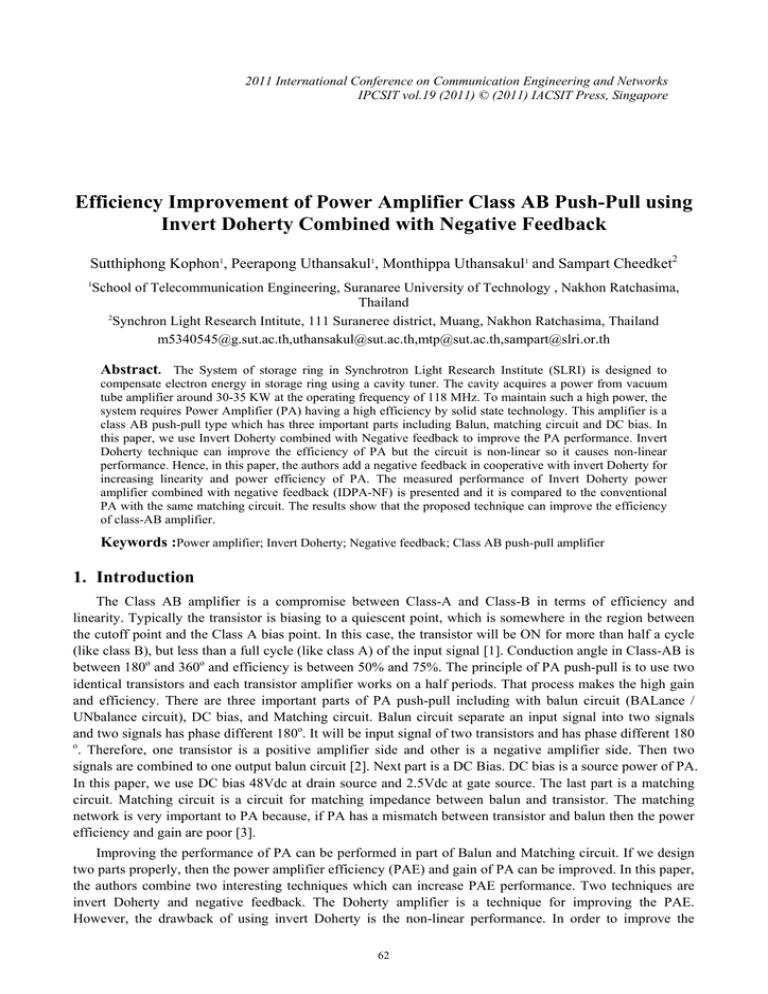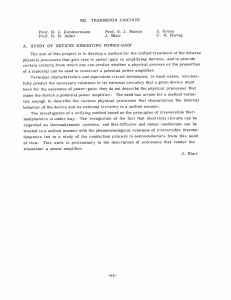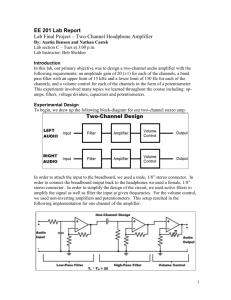Document 13135875
advertisement

2011 International Conference on Communication Engineering and Networks IPCSIT vol.19 (2011) © (2011) IACSIT Press, Singapore Efficiency Improvement of Power Amplifier Class AB Push-Pull using Invert Doherty Combined with Negative Feedback Sutthiphong Kophon1, Peerapong Uthansakul1, Monthippa Uthansakul1 and Sampart Cheedket2 School of Telecommunication Engineering, Suranaree University of Technology , Nakhon Ratchasima, Thailand 2 Synchron Light Research Intitute, 111 Suraneree district, Muang, Nakhon Ratchasima, Thailand m5340545@g.sut.ac.th,uthansakul@sut.ac.th,mtp@sut.ac.th,sampart@slri.or.th 1 Abstract. The System of storage ring in Synchrotron Light Research Institute (SLRI) is designed to compensate electron energy in storage ring using a cavity tuner. The cavity acquires a power from vacuum tube amplifier around 30-35 KW at the operating frequency of 118 MHz. To maintain such a high power, the system requires Power Amplifier (PA) having a high efficiency by solid state technology. This amplifier is a class AB push-pull type which has three important parts including Balun, matching circuit and DC bias. In this paper, we use Invert Doherty combined with Negative feedback to improve the PA performance. Invert Doherty technique can improve the efficiency of PA but the circuit is non-linear so it causes non-linear performance. Hence, in this paper, the authors add a negative feedback in cooperative with invert Doherty for increasing linearity and power efficiency of PA. The measured performance of Invert Doherty power amplifier combined with negative feedback (IDPA-NF) is presented and it is compared to the conventional PA with the same matching circuit. The results show that the proposed technique can improve the efficiency of class-AB amplifier. Keywords :Power amplifier; Invert Doherty; Negative feedback; Class AB push-pull amplifier 1. Introduction The Class AB amplifier is a compromise between Class-A and Class-B in terms of efficiency and linearity. Typically the transistor is biasing to a quiescent point, which is somewhere in the region between the cutoff point and the Class A bias point. In this case, the transistor will be ON for more than half a cycle (like class B), but less than a full cycle (like class A) of the input signal [1]. Conduction angle in Class-AB is between 180o and 360o and efficiency is between 50% and 75%. The principle of PA push-pull is to use two identical transistors and each transistor amplifier works on a half periods. That process makes the high gain and efficiency. There are three important parts of PA push-pull including with balun circuit (BALance / UNbalance circuit), DC bias, and Matching circuit. Balun circuit separate an input signal into two signals and two signals has phase different 180o. It will be input signal of two transistors and has phase different 180 o . Therefore, one transistor is a positive amplifier side and other is a negative amplifier side. Then two signals are combined to one output balun circuit [2]. Next part is a DC Bias. DC bias is a source power of PA. In this paper, we use DC bias 48Vdc at drain source and 2.5Vdc at gate source. The last part is a matching circuit. Matching circuit is a circuit for matching impedance between balun and transistor. The matching network is very important to PA because, if PA has a mismatch between transistor and balun then the power efficiency and gain are poor [3]. Improving the performance of PA can be performed in part of Balun and Matching circuit. If we design two parts properly, then the power amplifier efficiency (PAE) and gain of PA can be improved. In this paper, the authors combine two interesting techniques which can increase PAE performance. Two techniques are invert Doherty and negative feedback. The Doherty amplifier is a technique for improving the PAE. However, the drawback of using invert Doherty is the non-linear performance. In order to improve the 62 linearity, the combining of negative feedback is proposed to solve the problem of non-linearity. This is very important to the project of SLRI because the non-linearity can cause the unexpected signal spurring in the cavity tuner. Hence, the authors focus on both efficiency improvement and linearity control. 2. Inverse Doherty Power Amplifier (IDPA) Invert Doherty Power Amplifier is a technique for improving the PAE. In a Doherty amplifier, the output powers of two amplifiers operating at a proper phase alignment and bias level are combined using a quarterwave transmission line without the use of any additional components [4]. The classical Doherty amplifier configuration is illustrated in Fig.1. In general, the IDPA is used for aligning signals before sending them into transistor and before combining output signals. However, for the part of input transistor, the length is very short. Then, in this paper, the PA has ID only on output side. The calculated transmission line for ID technique is approximate at 25 ohm. The result of PA when adding ID technique will cause the power efficiency more non-linear. This is because ID technique provides the best performance based on transmission line matching in which its response is non-linear function to output signal. In this paper, the authors propose the combining of negative Figure 1. Schematic diagram of the classical Doherty amplifier. Figure 2. Schematic diagram of Negative feedback amplifier. feedback technique with ID technique to solve the non-linear problem. 3. Negative Feedback (NF) Negative Feedback is a technique to feedback signal from output of transistor (Drain) to input of transistor (Gate). That feedback process will perform a subtraction between input signals with feedback signal. In this paper, the authors choose the component circuits such as capacitors and resistors to perform the feedback signal. The negative feedback technique can greatly improve the PA performance including with a non-linear distortion, log-gain stability and band pass width [5]. Although the PA performance is more linear when using a negative feedback but its drawback is on the matching input. The matching unit of feedback technique degrades S11 performance but in a little. Hence, it is a perfect choice for applying feedback technique with IDPA in order to solve a linearity problem. Then, the proposed technique offers the higher efficiency as well as a good linear performance. 4. Power Amplifier Performance The selected PA type in this paper is aimed to practically implement for the project of SLRI at 118MHz. It is used for cavity driving in storage ring of SLRI. The authors design power amplifier in Class AB push - 63 pull type. For this type, there are three important parts including Balun circuit, matching circuit and DC bias. The design of each part will affect to operation, efficiency and stability of PA. The first key factors on designing PA for a task of SLRI are power efficiency and return loss. If the value of return loss is too high, it means that the risk of generator breakdown is very high. In this paper, the design of PA neglects a harmonic problem because the cavity has a reliable low-pass filter. For SLRI project, the transistor chip BLF578 is selected for purpose of power amplifier because it provides an excellent ruggedness, a good thermal stability and high power efficiency [6]. This device is a product of NXP semiconductor. It can operate in a frequency band of 10 - 500 MHz with a supply voltage of 50 V. For typical use at 225 MHz, the load power is 1200W and power Gain is 24dB with 71% power efficiency [7]. This device is sensitive to Electro Static Discharge (ESD) and a storage temperature is limited to 150oC. However, the low level system of SLRI project operates at 118 MHz. Therefore, the designs in this paper focus on this frequency operation and try it best to fit the highest performance at 118 MHz. 5. Simulation The simulations of PA class AB push-pull are performed via Microwave office (AWR). The input power of 0.8-2 watt (29-33 dBm) is set. Figure 3 presents S-parameters of the best fit design at 118 MHz. As seen in this figure, the invert Doherty technique can decrease the value of S11 which it means that the reflected power also decreases. Consider a negative feedback technique; the S11 performance is slightly increased. It means that the feedback slightly destroys a PA matching. Also in this figure, the proposed technique that combines invert Doherty and negative feedback can improve the S11 performance. In figure 4, the PAE performance of PA is presented. For a normal PA, it has PEA 76.3% at input 30 dBm. When applying an invert Doherty, the PAE increases to 76.75%. However, the effects of IDPA cause the non-linear results of PAE performance. After taking a negative feedback to PA, there is no change to PAE performance. For the case of IDPA combined with negative feedback, the PAE performance is obviously improved to 78% as shown in figure 4. Figure 3. Simulation of PA in S-parameter. Figure 4. Simulation of PA in power efficiency 64 Figure 5. Simulation of PA in power gain. Figure 6. Simulation of PA in P1dB The power gain of PA is also tested and shown in figure 5. It is noticed that the power gain of PA when an invert Doherty technique is used can increase gain but the non-linear problem is a tradeoff. As expected, the use of IDPA combined with negative feedback increases the power gain along with linear property. Figure 6 shows the performance of power input comparing with power output (P1dB) in a dBm scale. The results confirm the same trends as described in figure 4 and figure 5. I. MEASUREMENT For measurements, the block diagram of power efficiency measurement is shown in figure 7 and the real equipment setup is shown in figure 8. The real prototype of IDPA combined with a negative feedback is shown in figure 9. In our measurement, the directional coupler is used to tap a small output signal and then it is measured by power meter. The limitation of tested output power is around 800W Figure 7. Block diagram of power efficiency measurement 65 Figure 8. Measurement setup Figure 9. The prototype of IDPA combined with a negative feedback. because the circulator has a power limit at 800W. The measured results of power efficiency are shown in figure 10. It is obviously seen that the trends of measurement are the same as simulation. However, the measured values are less than the ones in simulation because the unexpected loss occurred within the real prototype. In figure 11, the measured results of power gain are presented. It is interesting to observe that the trends are different from simulation. In measurements, the proposed technique can improve power gain with a significant. The results of P1dB are also measured and shown in figure 12. The results confirm that the proposed technique can improve the system performance in both simulations and measurements. 6. Conclusion PA class AB push-pull can increase performance by adding invert Doherty technique but the non-linear property is its drawback. Thus, this paper proposes the negative feedback to combine with invert Doherty power amplifier to fix the drawback. Three system performances including with power efficiency, power gain and power input/output ratio are investigated. Both simulation and measurement results confirm that the proposed technique can improve performance of PA class AB push-pull. 7. Acknowledgment The authors thank the financial support from Synchrotron Light Research Institute (SLRI), Nakhon Ratchasima, Thailand. 8. References [1] Dr. Khalid K Mohammed, Rund B. Mohammed , “Linearization of Power Amplifier Class AB Using Cartesian Feedback.” International Multi-Conference on Systems 7th, Signals and Devices, 2010. [2] “Three Balun Designs for Push-Pull Amplifiers”, Motorola AN1034, 1993. [3] Steve C. Cripps. (2002) “Advanced Techniques in RF Power Amplifier Design”, Boston London, Artech House Microwave Library. [4] Gunhyun Ahn, Min-su Kim, Hyun-chul Park, Sung-chan Jung, Ju-ho Van, Hanjin Cho, Sung-wook Kwon, Jonghyuk Jeong, Kyung-hoon Lim, Jae Young Kim, Sung Chan Song, Cheon-seok Park and Youngoo Yang. (JUNE 66 2007) “Design of a High-Efficiency and High-Power Inverted Doherty Amplifier” IEEE TRANSACTIONS ON MICROWAVE THEORY AND TECHNIQUES, vol.55, NO.6, P.1105-1111. [5] Liao, S.Y. (1987) “Microwave circuit analysis and amplifier design” Prentice Hall. [6] "Using the BLF578 in the 88 MHz to 108 MHz FM band" AN10800, Application note, Rev. 01, 13 October 2009. [7] "BLF578 Power LDMOS transistor" data sheet, Rev. 02, 4 February 2010 Figure 10. Measurement of PA in power efficiency Figure 11. Measurement of PA in power gain. Figure 12. Measurement of PA in P1dB 67








